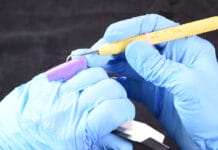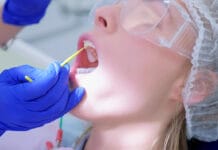In dental hygiene school, I remember being taught the efficacy and benefits of fluoride on the dentition nearly from day one. There were never any questions asked nor did students doubt what this element was capable of. We studied the content in our “dental hygiene bibles,” a.k.a. Textbooks, and as we transitioned into clinic, the proof was simply in the pudding.
During my second year of the dental hygiene program, I received a patient check from an instructor who also happened to be a registered dental hygienist in the community. On that form was a check-off section for topics discussed during oral hygiene instruction. I proudly presented my form feeling confident I had done my best. The instructor called me over to review my grade. She commended me for a great job but felt that I should have discussed fluoride with my patient. Her reasoning was simple, “because just about everyone can benefit from fluoride.” That little nugget of information stayed with me for years to come and to date is still something I feel passionate about.
Recently my town contemplated removing water fluoridation from the town water supply. Shame on me, I am not a huge newspaper connoisseur and learned about this information from a patient. I was surprised and angry all at the same time at this discovery. I immediately researched this for myself to also realize that the town planned on holding a public meeting specifically for this topic discussion, and encouraged those with an opinion, either way, to attend.
I began researching and gathering all the facts I could to present why removing fluoride from the community water supply was a mistake. With my ducks all in a row, I nervously attended the meeting that night, alone. When my name was called to speak, I approached the town council and stated my facts as convincing as humanly possible. I was the only dental hygienist who spoke. The meeting was adjourned, and the decision would not be made for months to come. Before I reveal the results of this matter lets review this marvelous element and how it all began.
As of 2016, 74.4% of the US population receives water fluoridation.[1] So, where did water fluoridation begin? In the early 1900s, research began on water fluoridation after several doctors discovered that mottled teeth, later diagnosed as fluorosis, were resistant to decay. Over the next 40 years, researchers conducted multiple studies and collected compelling evidence to support water fluoridation at optimal levels. In 1945, Grand Rapids, Michigan became the first town to implement a water fluoridation program.[2]
For more than 70 years communities have had access to water fluoridation, but sadly more and more people began to question the efficacy and safeness of this element. A part of me suspects the world of false information floating on the web as part of that reason, along with the more common desire of others to lead a more “natural” life, as another. Here is a fun fact, fluoride is a naturally occurring element!
Many anti-fluoride groups will gladly bring up the topic of where town water companies purchase their fluoride. The average person will cringe when they learn this tidbit of information. But once you understand the logic, it makes perfect sense. Fluoride is purchased from the fertilizer industry. Big shock huh? When phosphate is mined for the fertilizer industry, its raw, natural form is usually laden with fluoride and other natural elements.[3] The phosphate must be separated from the fluoride, as fluoride has no benefit in fertilizer, but does for dentifrice and water. Therefore, it only makes sense that these industries would sell what they cannot use. Another product that is also extracted from phosphate rock at this stage is phosphoric acid, a key ingredient in many popular colas.[4] However, no one blinks an eye at chugging a soda, nor do they create groups to remove it from the store shelves.
Another myth that you may hear about fluoride is that it is poison. What we must keep in mind is that everything consumable has an LD50, a reference point of lethality. LD50 is the dosage, in grams per kilogram of body weight, at which point one half of a given sample of test subjects will die.[3] This means that at the average American body weight of 80.7kg, one would have to consume 4,675 gallons of water at once, at a typical fluoridation level of 0.7 mg per liter of water, before lethality is reached.[3] I don’t know about you, but that’s a little more water than I can handle at a time.
Many will also attempt to prove that fluoride is in rat poison, therefore, making it lethal. Many rat poisons contain a chemical compound known as fluoroacetamide, a chemical compound consisting of fluorine, oxygen, and amidogen.[3] However, this fluoride is very different than what we consume in our water or use in our dentifrice. How so? Keep in mind that when different elements are compounded they produce a different result. Chlorine gas is highly lethal when alone, and pure sodium is known to combust. However, when the two are compounded to form sodium chloride, table salt is born. Thus, it is important to know your science when making “scientific-based” assumptions.
Other claims are fluoride impacts the body in various ways, from lowering I.Q., calcifying the pineal gland, and causing cancer. Pineal glands calcify as the body matures, and by age 17, pineal gland calcification is apparent in up to 40% of Americans. In other words, calcification of the pineal gland is hardly remarkable.[3] If the theories regarding I.Q. were true, then the average American I.Q. would have decreased over time. Instead, the average I.Q. has steadily risen since 1932, discrediting this theory, considering water fluoridation did not begin until the 1940s and 1950s.[3] Lastly, researchers have found no evidence that water fluoridation causes cancer. Multiple studies have been performed, with each the same result. More recent population-based studies using cancer registry data found no evidence of an association between fluoride in drinking water and the risk of osteosarcoma or Ewing sarcoma.[5]
There are mounds of evidence proving the efficacy of fluoride on the oral dentition. The CDC named community water fluoridation one of 10 great public health achievements of the 20th century. Water fluoridation alone reduces dental decay by about 20- 40% of children and adults.[2] Water fluoridation is the most cost-effective means to help reduce dental decay. On average, it costs the American family $.50 a year for water fluoridation and $3.00 a year in larger cities. For most cities, every $1 invested in water fluoridation saves $38 in dental treatment costs.[3] Delta Dental of Arkansas Foundation even has contributed almost 7 million dollars to improve thirty-two water systems.[6] How can anyone deny the benefits when over 100 national and international organizations support water fluoridation?
Fluoride has not changed over the course of 70 years. It is the same natural beneficial element now as it was in 1940. The only thing that has changed is opinion and junk science floating on the web. Fluoride has multiple benefits, from reducing dental decay to decreasing dental sensitivity. I will continue to recommend and suggest fluoridation to my patients, and I hope you will too. And by the way, after a long hard fight, my town reversed their decision and voted to maintain water fluoridation.
SEE ALSO: A Practical Look at Silver Diamine Fluoride
DON’T MISS: Polishing: Are You Spinning in Circles or Ready to Ride the Wave?
Now Listen to the Today’s RDH Dental Hygiene Podcast Below:
References
- “Fluoride Statistics.” Centers for Disease Control and Prevention. (19 Aug 2016). Retrieved from www.cdc.gov/fluoridation/statistics/2014stats.htm.
- McGinley, RDH, MBA J.S., Stouflett, RDH, MHS, N.M., Rubin, Mark. “Fluoridation Facts.” American Dental Association. (2005).
- Butala, Nate. “Fluoride – Tiny Element, Massive Impact.” Friends of Hu-Friedy. Retrieved from https://friendsofhu-friedy.force.com/FOHF/s/news/a2H36000001xqHFEAY/fluoride-tiny-element-massive-impact.
- American Academy of Pediatrics. (2015). Fluoride Myths and Facts. Retrieved from Campaign for Dental Health http://ilikemyteeth.org/fluoridation/fluoride-myths-facts/.
- “Fluoridated Water.” National Cancer Institute. (15 May 2017). Retrieved from www.cancer.gov/about-cancer/causes-prevention/risk/myths/fluoridated-water-fact-sheet.
- “Fluoridation.” Prevention. Retrieved from www.deltadentalar.com/Foundation/prevention.












